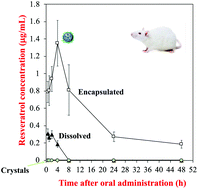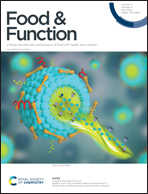Resveratrol-loaded biopolymer core–shell nanoparticles: bioavailability and anti-inflammatory effects†
Abstract
The cellular uptake and simulated intestinal wall transportation of resveratrol-loaded zein/pectin nanoparticles were assessed using Caco-2 cells and monolayers, respectively. The oral bioavailabilities of encapsulated (En-RES) and free (RES) resveratrol were evaluated by monitoring the resveratrol concentration in rat plasma after oral administration. The impact of encapsulation on the anti-inflammatory activity of the resveratrol was determined using lipopolysaccharide (LPS)-treated RAW 264.7 macrophages. The cellular uptake of encapsulated resveratrol increased appreciably with observation time (1–4 h), reaching a maximum value (≈1.06 μg mL−1) after 2 h, whereas that of free resveratrol (in DMSO) only increased slightly, reaching 0.62 μg mL−1 after 4 h. The transmembrane transport of En-RES was significantly higher than that of RES (p < 0.05): the resveratrol concentration in the receiving compartment of Costar trans-wells was 4.7-fold higher for the encapsulated resveratrol. The resveratrol concentration in the plasma of rats was measured after they were fed formulations containing a resveratrol equivalent of 20 mg per kg bodyweight. The plasma level reached a maximum value of 1.35 ± 0.26 μg mL−1 at 4 h after feeding the En-RES formulation, and then decreased to 0.19 ± 0.04 μg mL−1 after 48 h. Conversely, the plasma level only reached a maximum value of 0.31 ± 0.05 μg mL−1 at 0.5 h after feeding the free resveratrol formulation (an aqueous PEG 400 solution), and was totally cleared after 8 h. Cell culture studies suggested that En-RES exhibited a strong anti-inflammatory activity by inhibiting the production of NO, PGE2, IL-1β, IL-6, TNF-α, promoting IL-10 release, inhibiting expression of TLR4, and inhibiting phosphorylation of JNK, ERK1/2, p38 and MAPK. Overall, this research suggests that zein-pectin core/shell nanoparticles are a highly effective delivery system for resveratrol, significantly increasing its bioavailability and anti-inflammation activity. These oral delivery systems may be particularly suitable for applications in functional foods or pharmaceuticals.



 Please wait while we load your content...
Please wait while we load your content...